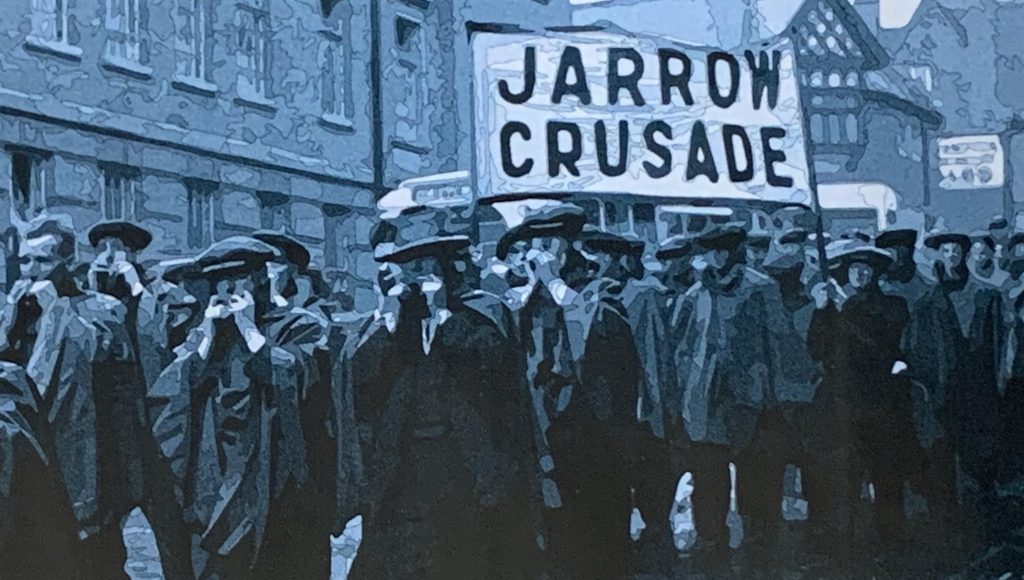Local history: the Jarrow March
24th September 2020
Caroline Aston tells us how Market Harborough played a part in one of the most iconic events of the 1930s
History is peppered with dark and difficult episodes – revolutions, wars, natural disasters, economic boom and bust. And 2020 will, of course, go down as the year of a global health crisis that impacted the lives of just about every man, woman and child living, a time of financial collapse and unprecedented curbs of treasured personal freedoms. Perhaps the time is right to look back in time to the great slump of the 1930s – and how Market Harborough played a part in one of the most iconic events of that dire decade.

October 1936 and the paper-reading public were gripped by a front-page story. On the 5th of that month a small army of 200 unemployed men had set out to march almost 300 miles from Jarrow, then in County Durham, to London. Jarrow was a grim place to live, in terminal decline following the closure in 1934 of Palmer’s Shipyard and Iron Company, which had employed 10,000 men at its height. Eight out of every 10 men were unemployed, and most houses were overcrowded, vermin-infested slums. What state benefit existed, the ‘dole’, was means-tested, nursing mothers even being asked if they breastfed their babies – if they did, their money was cut! J.B. Priestley visiting Jarrow wrote that the men had the look of prisoners of war and that the place ‘looked as though it had entered a perpetual, penniless bleak Sabbath’.
But Jarrow did not lack spirit: a delegation met with Walter Runciman, President of the Board of Trade, to ask for assistance in regeneration. His response? ‘Jarrow must work out its own salvation’ – an answer described as ‘the last straw in official cruelty’. Undaunted, a huge public meeting in July 1936 decided to petition for government help in the form of a new steel works to create jobs. But how to deliver this petition to London? A voice shouted from the gallery – ‘Let’s march down with it’ – and so began the famous ‘Jarrow Crusade’, a title underlining the almost religious fervour of those who took part.
A thousand men volunteered, but only 200 were deemed fit enough to walk the distance; weeks of a subsistence diet had taken their toll. The expedition was planned with military precision, and many of the men were veterans of the 1914-18 Great War. These ex-soldiers now fighting a different kind of battle would march again, in step and in time to a kettle drum beat and Tosh Corry’s harmonica band. Two medical students would provide care on the long walk, and no drunken behaviour would be tolerated.
The group would start from a church following a blessing by religious leaders, underlining the ‘crusade’ aspect, and Jarrow’s Labour MP ‘Red Ellen’ Wilkinson would march with the men. However, the Labour Party, keen to be seen as moderate, was surprisingly lukewarm, while the Trades Union Council actually issued a circular denouncing the initiative.
Off marched the men of Jarrow, carrying their 10,000-name petition. The long trek was divided into 22 stages, each covering between 9 and 21 miles, and, if officialdom had been unsupportive, the same could not be said of the great British public. Support grew steadily, with donations of cash, clothing and food – beef paste sandwiches were washed down with cauldrons of soup.
On 22 October they arrived in Leicester, where the city’s cobblers worked through the night to repair their boots. Next day the men set off for Market Harborough. It has to be said that the Jarrow Crusade was not exactly welcomed with open arms. From 1930 onwards there had been major improvements and building in Harborough, and this column of gaunt men with their uncomfortable political message, a reminder of the darker side of 1930s’ life, did not chime well. Though welcomed by Cyril Bardsley, Bishop of Leicester, it was reported that they slept on the damp stone floor of a semi-finished building and that hospitality was more basic than at some other stops. They left Market Harborough early the next day, eventually arriving in London in pouring rain on 31 October, trailed by Special Branch.
‘It was a waste of time… but I enjoyed every step.’
The result? The Prime Minister refused to see them, the petition was delivered and never seen again, and the men came home by train, their fares plus cheap new suits bought with money collected. While some had put on weight due to regular simple meals, the whole event is best summed up by one of those men who marched into Market Harborough 84 years ago. Con Whalen, who died in 2003, simply said: ‘It was a waste of time… but I enjoyed every step.’



